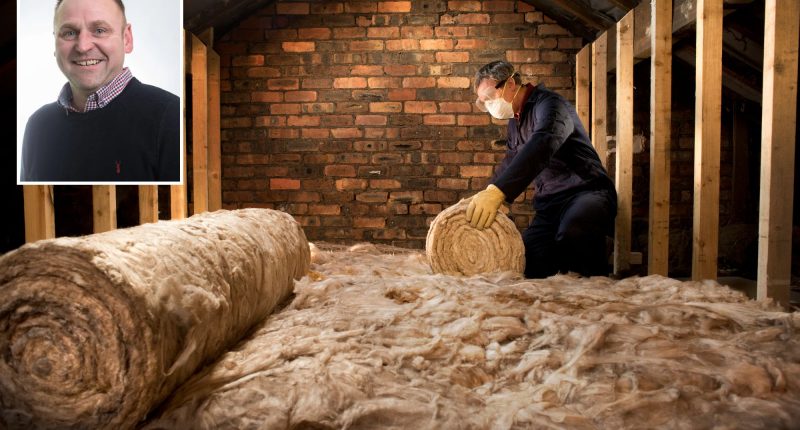MILLIONS of households could be wasting an extra £590 on heating costs due to poor or no loft insulation.
Insulation works by creating a thermal barrier that traps natural heat within the home, keeping rooms warm and creating less need to switch on the central heating.
Heat rises and in a typical British home, 25% of your heat goes out through your ceiling, into your loft and out of through the roof.
Most people have some loft insulation, usually between the joists and maybe two or three inches in depth.
However, experts in the trade recommend insulation with a depth treble of this amount to feel the maximum benefit.
The Sun spoke to Dean Taylor, an insulation expert and the founder of The Loft Boys to find out how households should check their insulation.
Read more in money
He also shares exactly how to determine if you have enough or if you need a top-up.
How do I go about checking my insulation?
Dean recommends that homeowners venture upstairs into their loft space to get an idea of whether or not their roof is insulated.
He said: “If you can safely access your loft hatch, you should do so and bring up a ruler or tape measure.
“Find a gap between some insulation and a joist (the large wooden beams that run across the floor of your loft).
Most read in Money
“Use your measuring device to check the depth of the insulation and jot that down on some paper.
“You should also make a note of how much of the loft space is covered with insulation (if any).
“You will want to have insulation to a depth of 270mm – or about the length of a 30cm ruler.”
Of course, if you have loft boarding installed you will need to find a floorboard that’s loose or at least one you can get some leverage on with a claw hammer.
You should then be able to lift that up and get a look underneath before measuring the insulation depth.
“But be careful not to damage any electrical cables or pipework that may be beneath the board you are choosing to lift.
“If you discover that you have no insulation or a lot less than the recommended depth then you should consider getting more so that you can fully take advantage of the energy-saving benefits it provides,” said Dean.
Without doing so you’ll be wasting up to £590 per year more than you need to in heating costs.
Can’t access your loft?
Dean said: “If you can’t access your loft – as maybe it’s unsafe to do so, or you have no loft ladder installed, then simply ask yourself whether the upper part of your house is hot during summer, and very cold during winter?
“This likely shows that you have insufficient (or no) loft insulation installed.
“At this point, you can call a professional to come and check properly.”
Dean said you can also check for a draught coming from your loft hatch.
He said that if you feel a strong draft here it’s likely you have no insulation installed and/or the loft hatch doesn’t have any draft excluder installed.
“Having a draughty loft hatch is like having a window open – so you will want to get that sorted by a professional,” said Dean.
How much does loft space insulation cost?
The average homeowner looking to install basic quilt insulation in their loft can expect to pay £670 on materials and £250 a day in labour costs, according to Checkatrade.
But the exact amount you’ll pay will depend on the exact style and size of your home.
Average material costs based on property type and according to Checkatrade are as follows:
- Terrace house – £550
- Semi-detached house – £670
- Detached house – £930
- Bungalow – £930
You may incur extra costs if electrical wiring and pipework need to be relocated.
However, hundreds of thousands of households are eligible for free insulation under certain government schemes.
How can I get free insulation?
The government’s Great British Insulation Scheme offers free or cheaper insulation to reduce the energy bills of around 400,000 homes.
You might get support if your home has an EPC of D-G, or your home is in a council tax band A-D in England or A-E in Scotland or Wales.
You can check your eligibility by visiting https://www.gov.uk/apply-great-british-insulation-scheme.
A separate scheme called The Energy Company Obligation (ECO) scheme is designed for those on low incomes.
You might be eligible for help if you live in private housing and get one of the following benefits:
- Tax credits
- Universal Credit
- Pension Credit
- Income support
- Income-based jobseeker’s allowance (JSA)
- Income-related employment and support allowance (ESA)
- Child benefit
- Housing benefit
If you own your house, it must have an energy efficiency rating of D, E, F or G to be eligible.
If you rent from a private landlord, the house must have an energy efficiency rating of E, F or G to be eligible. You must have the owner’s permission to do the work.
Read More on The Sun
Contact your local council to find out if they’re taking part in the ECO scheme, or contact an energy supplier directly.
You can find contact details of suppliers who are taking part in the scheme on the Ofgem website.










